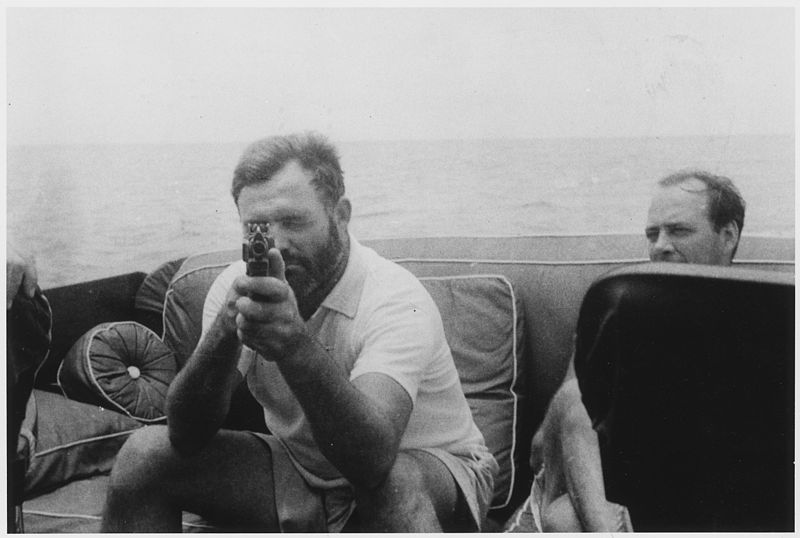The Toxic Relationship Between Man and Boat in Two Key West Fiction Classics

Key West’s heritage is directly tied to dangerous maritime businesses. Around the turn of the nineteenth century, the wrecking industry made the city one of the wealthiest in the country. It was customary that the spotter of a shipwreck yell “WRECK ASHORE,” and that everybody who heard him echo the discovery, making each wreck a community-wide event. All the wreckers would race out to the reefs, often while storms still raged. It was the right of the wrecker to take from the ship’s cargo if he aided in the rescue of the ship’s crew. As a result, many died in pursuit of wrecks that could very well have had no precious cargo.
City legend has it that in the midst of the wrecking boom, while delivering a Sunday sermon, a preacher spotted a ship running up on the reef out the window behind his congregation. The sermon was about greed. He slowly walked to the back of the church as he preached and, only when he’d secured a comfortable pole position, yelled “WRECK ASHORE,” before running out ahead of his wrecker congregants. In Key West, the only God was, and still is, cash. The city’s wealth, prominence, and physical beauty attracted Cuban exiles, poets, and luminaries alike. This southernmost city in the United States, too, was not only a wrecking capital, but also a tobacco capital, fishing capital, and major port of entry for all contraband. One such piece of imported contraband was Ernest Hemingway.
Hemingway wasn’t the first writer to fictionalize the Conch Republic, but he remains the most famous; any conversation about the city and literature inevitably lands on him and his outrageous behavior. He once knocked out an elderly, overweight Wallace Stevens, for example. He also illegally constructed Key West’s first residential swimming pool. Arlo Haskell, executive director of the Key West Literary Seminar, noted that the nonprofit’s purchase of Elizabeth Bishop’s home “felt like a feminist response to all the Hemingway energy that goes on here.” His novel To Have and Have Not (1937) is his only full-length work of fiction set in Key West. It’s about a boat captain named Harry Morgan and is a pure reflection of the author’s island persona—a rum-running, gun-toting sunuvabitch whose dubious dealings are only outnumbered by his racial slurs. Of the book, one thing is sure—it does not stand the test of time.
At the outset of the novel, Morgan falls on hard financial times—a tourist he’d been guiding for weeks flies out on his bill and expenses. Morgan is hard up in Havana when he’s offered work of a more sensitive nature: the transport of a boatload of Chinese immigrants from Havana to Key West. When it’s time to depart, however, he opts instead to kill the man with whom he set up the deal and return the human cargo back to Cuba with no remorse. He sails off into the Gulf Stream with his drunken, useless first mate, a “rummy” of the lowest order. A sadist’s picture of romance that only Hemingway could draw.
Readers don’t always have to love or sympathize with protagonists, but writers must give their characters clear goals and set them on the path to achieving them. Harry Morgan is a bloodthirsty psycho, but at least we know he’s after his boat, and by proxy, the Yankee dollar. These sole pursuits are not necessarily noble, but they are pursuits no less. About the character, Hemingway writes, “When he was in a boat he always felt good and without his boat he felt plenty bad.” Morgan forfeits his boat to the law in a failed rum haul. He also loses an arm in a shootout and all that’s left of it is described as a paddle, ironically making Captain Morgan more seaworthy. Neither of these obstacles will stop him from getting his boat back. He’s already committed himself to more work and is “glad of an excuse to steal her. He knew he couldn’t keep her but maybe he could make a piece of money with her while he had her.” It’s not that Hemingway’s protagonist chases paydays so he can support his wife—though she supports him, helping him load a tommie gun before his fateful mission—it’s that he needs money to fix his boat and pay for gas.
John Steinbeck famously addressed the man/boat relationship in his book The Log from the Sea of Cortez (1951). “Man, building this greatest and most personal of all tools,” he writes, “has in turn received a boat-shaped mind, and the boat, a man-shaped soul. His spirit and the tendrils of his feeling are so deep in a boat that the identification is complete.” What is certain about the protagonist of To Have and Have Not is that he definitely doesn’t have a brain-shaped mind inside of his head. Accepting this objectification of the character is accepting that he would inevitably die with his boat. And that he does.
Morgan steals his boat back and captains a bank robbery getaway. In his greed and paranoia, he decides to gun down the Cubans who’ve hired him. He gets sloppy, though, and leaves one of them alive. Perhaps if he’d had that extra arm instead of a paddle, he’d have done the job clean.
After getting shot in the stomach, Morgan lies on the floor of the boat as it drifts in the Gulf Stream. As he dies slowly, he loses the ability to discern the difference between himself and boat. “The bilge of the launch was full of gasoline,” Hemingway writes, “and when she rolled at all this made a sloshing sound. The man, Harry Morgan, believed this sound was in his own belly and it seemed to him now that his belly was big as a lake and that it sloshed on both shores at once.” It was always going to end this way for Morgan. The predictability of his death could be seen in his desperation to have his boat.
Morgan’s death may have heralded the end of bootlegging itself. The passing of the 21st Amendment in 1933 made alcohol sales legal in the United States. Then on Labor Day of 1935 a Category 4 hurricane hit the Florida Keys. It destroyed Henry Flagler’s Overseas Railroad and, though it was still possible to reach Key West by automobile and ferry, it made the island feel more remote. Though the recovery period was rough, this exclusivity ended up being part of the place’s allure. Each new decade from the ‘30s through the ‘60s meant the arrival of a new literary luminary—some notables were Tennessee Williams, Shel Silverstein, and Elizabeth Bishop.
It was during this time that Thomas McGuane wrote Ninety-Two in the Shade (1973), a darkly comic novel about a turf war between two fishing guides, Nichol Dance and Thomas Skelton. These fictional characters are inseparable from the actors who played them in the 1975 film adaptation of the novel, Warren Oates and Peter Fonda, respectively. The film, written and directed by McGuane himself, came to hold as notorious a presence in Key West as Hemingway achieved many years before. During filming, the actors and their wives slept with each other and hoovered Herculean amounts of cocaine, haunting the Key West streets into the early morning. Life imitated the art in this case as the characters in the book are toxic imbibers. Skelton, a trust fund pirate, wakes up in a Miami motel room after a heavy acid trip and decides that he’s going to get into guiding, a working-class profession. The prodigal son returns to Key West, but it’s an immediate affront to the territory of Dance, who’s got nothing else but this profession. He’s fresh off a divorce “that ended in the court reconciling everything he had acquired but a skiff”; Dance is protective of his only true possession and calling.
In Dance, McGuane creates a character with a history of violence who’s trying to let things go and enjoy Key West’s comforts. He decides to test the young guide’s salt by bring him out on the water. The two of them stand on Dance’s skiff. McGuane writes, “With the electrical hum of its motor, Nichol Dance began to stir. Tom Skelton forgot himself for the moment, forgot the rather lurid momentary circumstance and felt only his own fine tremble to be that of the boat when, choked and started, the powerful engine passed its life through the craft and sent fine lapping tremors out around itself into the tidal creek.” The guides connect with each other via the thrum of a boat engine—a noise that translates to camaraderie in the language of a fishing guide. In the world of Key West literature, men can only bond while staring at the ocean from a boat, without saying anything to each other. Hemingway’s Harry Morgan only eschewed this assertion because he either killed his boating companions or kept them liquored up enough so that they’d snore away in the cabin.
The friendship dissipates quickly as Dance realizes Skelton is talented and a true threat. Meanwhile, Skelton, probably still riding the heavy acid trip he’d been on prior to the action of the novel, is achieving oneness with the city. “He began to imagine,” McGuane writes, “that he could feel Key West urge itself against the Atlantic like a ship of terrible slow movement. The chrysalis he sometimes felt inside was beginning to shed and stream quite lambently.” He goes so far as to imagine that all of Key West is a boat, and it’s kind of tough to argue with this comparison. After all, Key West is a floating enterprise, susceptible to the ocean’s whims and fancies, from which people are cyclically embarking and disembarking.
Some of those recently embarked on the island cruise that is Key West become Skelton’s first charge—a pair of city slickers looking to fish the ever-elusive permit. This wealthy couple is a symbol for the next era of change that Key West would undergo after the seventies. One of commercialization and real estate speculation. The cruise ship tourist that pops in to catch their taste of Key West and pops back out as quickly as they came.
Skelton succeeds in tracking a permit for the couple, but the fish takes the bait into the mangroves. He wades into the thickets and finds the fish, but is in awe of its beauty and fight, so he lets it go. When he comes back out, the clients have disappeared from the skiff. Little does he know that Dance, Carter, and the city slickers are all in on a sinister trick to make Skelton think he’s killed his first paying clients. When Skelton finds out about the ruse, he gets rightfully upset. In fact, he gets so upset that he blows up Dance’s boat. There’s no turning back from this moment in the novel. The story goes from one of boys and their toys to one of life and death. The incident is a reminder of the dark current on which a tourist destination like Key West stays afloat. The ghost of Harry Morgan floats somewhere in the Gulf Stream not far offshore.
Dance wants to forgive Skelton. He knows they played a dirty trick on him. But then he hears that Skelton’s well-to-do grandfather has staked the young guide a brand-new boat. Their fortunes have reversed completely; a boatless Dance stews in his anger where he once might have found an outlet for it on his skiff. “The boat burns once more in his mind,” writes McGuane. “All that Nichol Dance owned, with the gas tank blowing sideways through the hull. Quicksink, scream of superheated gas, destruction bubbles, loss.”
The book rushes towards its inevitable end. In Key West stories, men who come between other men and their boats must pay the ultimate price. Skelton is settling into his business, blissfully guiding on his brand-new skiff. Key West is his oyster. He’s out on a job with clients when Dance pulls up next to him on another boat out on the flats. “Dance ran right in on them and cut his engine,” McGuane writes. “He climbed into Skelton’s boat and asked him where he wanted it.” It’s not only logical for the book to end in violence, but for the violence to have been preceded by the crossing from one boat into another.
The dangerous obsession with their vessels is what drives the story of Dance and Skelton forward to its end. Whatever had occupied these characters’ minds prior to the beginning of the book—for Dance, a wife in the Everglades and for Skelton, the trappings of youth—ends up replaced by the shape of a fourteen-foot skiff. In the novel, McGuane set out to capture the intensity of guiding culture. He succeeded in revealing this intensity, and that even if you cast Warren Oates and Peter Fonda in the main roles of a film adaptation, there’s no way to make this story of brutes romantic. McGuane’s Key West was a provincial one of turf wars, while Hemingway’s was one of international bootlegging. Both lurid depictions of boat-driven madness.
The relationship between man and boat in Key West today remains complicated. While the city’s population is only five percent the size of Miami’s, its cruise port handles half as much traffic. The food and beverage, souvenir, and tour guiding industries generate great wealth for a select handful of local residents, but the boats themselves destroy some of the city’s natural beauty, and statistically actually are a net loss to the city. It begs the question of what the next great boat novel of Key West will be. It also makes sense that, despite the lack of empathy in any of the characters in McGuane and Hemingway’s Key West novels, the stories remain local classics. The city is an international port of entry, an island where man and boat collide violently so that the lines between them become hard to distinguish.



